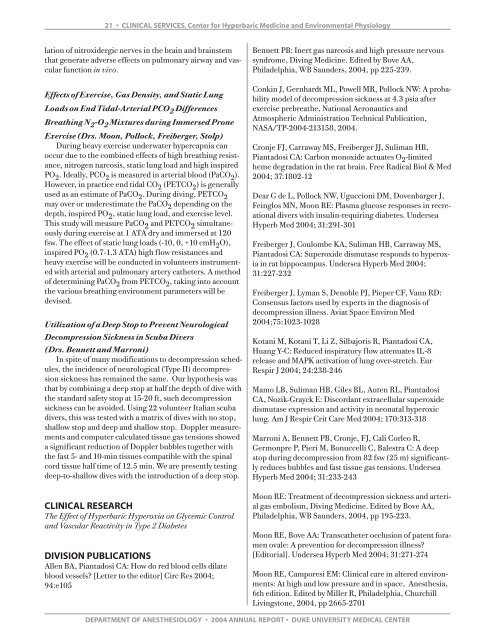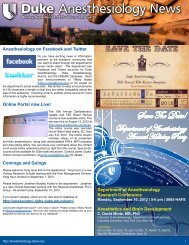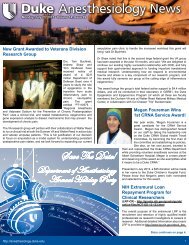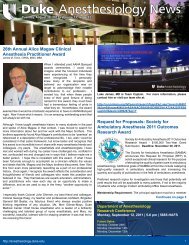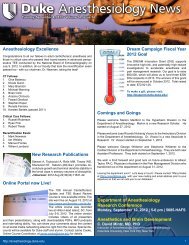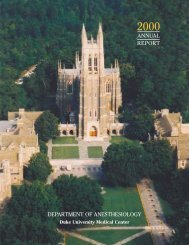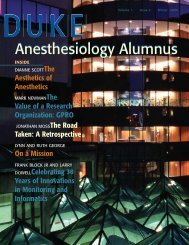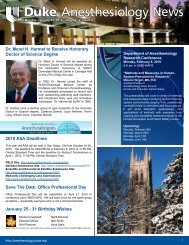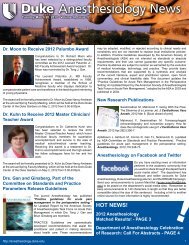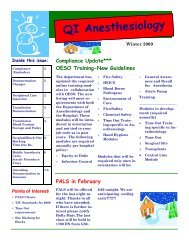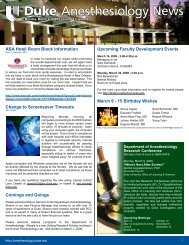2004 Annual Report - Department of Anesthesiology - Duke University
2004 Annual Report - Department of Anesthesiology - Duke University
2004 Annual Report - Department of Anesthesiology - Duke University
Create successful ePaper yourself
Turn your PDF publications into a flip-book with our unique Google optimized e-Paper software.
21 • CLINICAL SERVICES, Center for Hyperbaric Medicine and Environmental Physiology<br />
lation <strong>of</strong> nitroxidergic nerves in the brain and brainstem<br />
that generate adverse effects on pulmonary airway and vascular<br />
function in vivo.<br />
Effects <strong>of</strong> Exercise, Gas Density, and Static Lung<br />
Loads on End Tidal-Arterial PCO2 Differences<br />
Breathing N2-O2 Mixtures during Immersed Prone<br />
Exercise (Drs. Moon, Pollock, Freiberger, Stolp)<br />
During heavy exercise underwater hypercapnia can<br />
occur due to the combined effects <strong>of</strong> high breathing resistance,<br />
nitrogen narcosis, static lung load and high inspired<br />
PO2 . Ideally, PCO2 is measured in arterial blood (PaCO2 ).<br />
However, in practice end tidal CO2 (PETCO2 ) is generally<br />
used as an estimate <strong>of</strong> PaCO2 . During diving, PETCO2 may over or underestimate the PaCO2 depending on the<br />
depth, inspired PO2 , static lung load, and exercise level.<br />
This study will measure PaCO2 and PETCO2 simultaneously<br />
during exercise at 1 ATA dry and immersed at 120<br />
fsw. The effect <strong>of</strong> static lung loads (-10, 0, +10 cmH2O), inspired PO2 (0.7-1.3 ATA) high flow resistances and<br />
heavy exercise will be conducted in volunteers instrumented<br />
with arterial and pulmonary artery catheters. A method<br />
<strong>of</strong> determining PaCO2 from PETCO2 , taking into account<br />
the various breathing environment parameters will be<br />
devised.<br />
Utilization <strong>of</strong> a Deep Stop to Prevent Neurological<br />
Decompression Sickness in Scuba Divers<br />
(Drs. Bennett and Marroni)<br />
In spite <strong>of</strong> many modifications to decompression schedules,<br />
the incidence <strong>of</strong> neurological (Type II) decompression<br />
sickness has remained the same. Our hypothesis was<br />
that by combining a deep stop at half the depth <strong>of</strong> dive with<br />
the standard safety stop at 15-20 ft, such decompression<br />
sickness can be avoided. Using 22 volunteer Italian scuba<br />
divers, this was tested with a matrix <strong>of</strong> dives with no stop,<br />
shallow stop and deep and shallow stop. Doppler measurements<br />
and computer calculated tissue gas tensions showed<br />
a significant reduction <strong>of</strong> Doppler bubbles together with<br />
the fast 5- and 10-min tissues compatible with the spinal<br />
cord tissue half time <strong>of</strong> 12.5 min. We are presently testing<br />
deep-to-shallow dives with the introduction <strong>of</strong> a deep stop.<br />
CLINICAL RESEARCH<br />
The Effect <strong>of</strong> Hyperbaric Hyperoxia on Glycemic Control<br />
and Vascular Reactivity in Type 2 Diabetes<br />
DIVISION PUBLICATIONS<br />
Allen BA, Piantadosi CA: How do red blood cells dilate<br />
blood vessels? [Letter to the editor] Circ Res <strong>2004</strong>;<br />
94:e105<br />
Bennett PB: Inert gas narcosis and high pressure nervous<br />
syndrome, Diving Medicine. Edited by Bove AA,<br />
Philadelphia, WB Saunders, <strong>2004</strong>, pp 225-239.<br />
Conkin J, Gernhardt ML, Powell MR, Pollock NW: A probability<br />
model <strong>of</strong> decompression sickness at 4.3 psia after<br />
exercise prebreathe, National Aeronautics and<br />
Atmospheric Administration Technical Publication,<br />
NASA/TP-<strong>2004</strong>-213158, <strong>2004</strong>.<br />
Cronje FJ, Carraway MS, Freiberger JJ, Suliman HB,<br />
Piantadosi CA: Carbon monoxide actuates O 2 -limited<br />
heme degradation in the rat brain. Free Radical Biol & Med<br />
<strong>2004</strong>; 37:1802-12<br />
Dear G de L, Pollock NW, Uguccioni DM, Dovenbarger J,<br />
Feinglos MN, Moon RE: Plasma glucose responses in recreational<br />
divers with insulin-requiring diabetes. Undersea<br />
Hyperb Med <strong>2004</strong>; 31:291-301<br />
Freiberger J, Coulombe KA, Suliman HB, Carraway MS,<br />
Piantadosi CA: Superoxide dismutase responds to hyperoxia<br />
in rat hippocampus. Undersea Hyperb Med <strong>2004</strong>;<br />
31:227-232<br />
Freiberger J, Lyman S, Denoble PJ, Pieper CF, Vann RD:<br />
Consensus factors used by experts in the diagnosis <strong>of</strong><br />
decompression illness. Aviat Space Environ Med<br />
<strong>2004</strong>;75:1023-1028<br />
Kotani M, Kotani T, Li Z, Silbajoris R, Piantadosi CA,<br />
Huang Y-C: Reduced inspiratory flow attenuates IL-8<br />
release and MAPK activation <strong>of</strong> lung over-stretch. Eur<br />
Respir J <strong>2004</strong>; 24:238-246<br />
Mamo LB, Suliman HB, Giles BL, Auten RL, Piantadosi<br />
CA, Nozik-Grayck E: Discordant extracellular superoxide<br />
dismutase expression and activity in neonatal hyperoxic<br />
lung. Am J Respir Crit Care Med <strong>2004</strong>; 170:313-318<br />
Marroni A, Bennett PB, Cronje, FJ, Cali Corleo R,<br />
Germonpre P, Pieri M, Bonuccelli C, Balestra C: A deep<br />
stop during decompression from 82 fsw (25 m) significantly<br />
reduces bubbles and fast tissue gas tensions. Undersea<br />
Hyperb Med <strong>2004</strong>; 31:233-243<br />
Moon RE: Treatment <strong>of</strong> decompression sickness and arterial<br />
gas embolism, Diving Medicine. Edited by Bove AA,<br />
Philadelphia, WB Saunders, <strong>2004</strong>, pp 195-223.<br />
Moon RE, Bove AA: Transcatheter occlusion <strong>of</strong> patent foramen<br />
ovale: A prevention for decompression illness?<br />
[Editorial]. Undersea Hyperb Med <strong>2004</strong>; 31:271-274<br />
Moon RE, Camporesi EM: Clinical care in altered environments:<br />
At high and low pressure and in space, Anesthesia,<br />
6th edition. Edited by Miller R, Philadelphia, Churchill<br />
Livingstone, <strong>2004</strong>, pp 2665-2701<br />
DEPARTMENT OF ANESTHESIOLOGY • <strong>2004</strong> ANNUAL REPORT • DUKE UNIVERSITY MEDICAL CENTER


